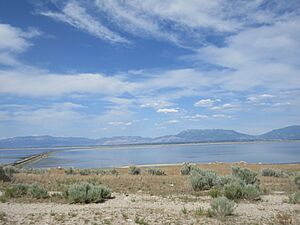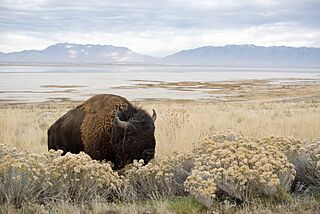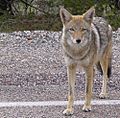Antelope Island facts for kids
Quick facts for kids Antelope Island State Park |
|
|---|---|
| Pa'ri-bi-na | |
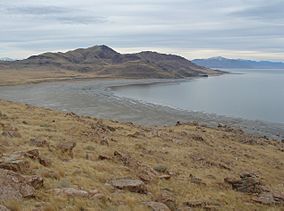
View from Buffalo Point, Antelope Island
|
|
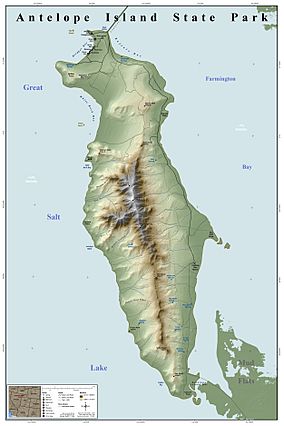
Map of Antelope Island State Park
|
|
| Location | Davis County, Utah, United States |
| Length | 24 km (15 mi) |
| Width | 7.8 km (4.8 mi) |
| Area | 109 km2 (42 sq mi) |
| Elevation | 5,325 ft (1,623 m) |
| Max. elevation | Frary Peak 6,596 ft (2,010 m) |
| Min. elevation | 4,200 ft (1,300 m) at the shore |
| Established | 1969 |
| Named for | Antelope Island |
| Visitors | 885,078 (in 2022) |
| Governing body | Utah State Parks |
Antelope Island is the biggest of ten islands in the Great Salt Lake in Utah. It covers about 42 square miles (109 km2). This island is in the southeastern part of the lake, close to Salt Lake City. When the lake's water level is very low, the island can even become a peninsula, meaning it connects to the mainland. Today, it is a protected area known as Antelope Island State Park.
The first non-native explorers to visit the island were John C. Frémont and Kit Carson in 1845. They rode across the salty ground and were told by Native Americans that the island had fresh water and many antelope. They shot a pronghorn antelope there and named the island "Antelope Island" to show their thanks for the food.
Antelope Island is home to many animals. You can find pronghorn, bighorn sheep, American bison, porcupines, badgers, coyotes, bobcats, and mule deer. Millions of waterfowl also visit the island. The bison were brought to the island in 1893. The Antelope Island bison herd is now very important for bison breeding and conservation. These bison do well because much of the island is covered in dry, native grassland.
The island's land is mostly flat plains with grassland in the north, east, and south. The middle of the island has mountains made of very old rocks. These rocks are even older than those at the bottom of the Grand Canyon.
Contents
Antelope Island: A Utah State Park

Antelope Island State Park covers the entire island. In the early 1900s, some people thought Antelope Island should become a national park because of its wildlife and beautiful views. However, this idea never happened. When the Utah State Parks System was created, there were plans to make Antelope Island a state park. People slowly started to support this idea.
At that time, Antelope Island was privately owned. It was used as a ranch for cattle and sheep. This started when the Mormon pioneers first arrived in the Salt Lake Valley. The Church of Jesus Christ of Latter-day Saints owned the ranch from 1848 until about 1870. In 1870, John Dooly Sr. bought the island. He started the Island Improvement Company, which managed the island and its ranches until 1981.
The State of Utah bought the northern part of the island (about 2,000 acres or 8.1 km2) in 1969. The state bought the rest of the island, including the historic Fielding Garr Ranch, in 1981. After this, the cattle and sheep were moved off the island. Antelope Island State Park officially opened in 1981 as part of the Utah State Parks System.
You can reach the island by driving on a 7-mile (11 km) causeway from Syracuse in Davis County. From Interstate 15, take exit 332 and head west on Antelope Drive (SR-108). Most of the island's shore is flat with beaches. The mountains on the island are very steep and can be seen from much of the northern Wasatch Front. The highest point is about 6,596 feet (2,010 m) high, which is about 2,396 feet (730 m) above the lake's level.
Antelope Island State Park also has a small radio station (530 kHz AM). It shares information about the park's hours and upcoming events. In 2010, about 280,000 people visited Antelope Island State Park, making it the fifth most-visited state park in Utah.
Island History
Early Native American Life
Archeological findings show that Native Americans lived in Utah about 10,000 to 12,000 years ago. These early people lived near the Great Basin's wetlands. They found plenty of fish, birds, and small animals there. Large animals like giant bison and mammoths also came to the water sources. Over time, the very large animals disappeared. American bison, mule deer, and pronghorn became more common.
Around 8000 BC, a new group called the Desert Archaic people lived in caves near the Great Salt Lake. They mostly gathered food like cattails and other plants that could grow in salty areas. Meat was not a common part of their diet. The Desert Archaic people used nets and a tool called an atlatl to hunt birds, small animals, and pronghorns. They left behind items like nets made from rabbit skin, woven sandals, and animal figures. About 3,500 years ago, the lake levels rose, and the number of Desert Archaic people seemed to drop a lot.
Evidence found at Antelope Island State Park shows that people lived on the island over 6,000 years ago. The island has forty freshwater springs. The Fielding Garr Ranch was built near the strongest spring. Archaeologists believe people have been active near these springs for at least 1,000 years.
The Fielding Garr Ranch Story
The first Anglo-Americans to explore the island were John C. Fremont and Kit Carson in 1845. They named it Antelope Island because of the many pronghorn they saw. Later, Captain Howard Stansbury used the island as a base to map the lake. He tried to find out where the lake's water drained, hoping to find a path to the Pacific Ocean.
The first person to live permanently on the island was Fielding Garr. He was sent by the LDS Church to start a ranch for the church's animals. The Fielding Garr Ranch was run by the church until the 1870s. It helped fund the Perpetual Emigration Fund, which helped Mormon converts from Europe move to Utah. The ranch house, built in 1848, is still standing. It is the oldest Mormon-built home in Utah that is still on its original foundation.
When the Transcontinental Railroad was built in 1869, more people could settle on the island. However, most of these settlements did not last. By 1900, the island was mostly empty except for the ranch.
John Dooly Sr. bought the island for one million dollars and started the Island Improvement Company. He is famous for bringing twelve American bison to the island on February 15, 1893. At that time, there were fewer than 1,000 bison left in all of North America. Historians think Dooly brought them to the island for commercial reasons, perhaps hoping to offer rare bison hunts. These twelve bison became the start of the Antelope Island bison herd. Today, this herd has between 500 and 700 animals. It is one of the largest and oldest publicly owned American bison herds in the United States.

John Dooly Jr. took over the ranch around 1902. He focused on raising sheep. The Fielding Garr Ranch became one of the biggest sheep ranching operations in the western United States. In the 1950s, the market for wool declined, so the ranch switched to raising cattle. It became one of Utah's largest cattle operations until 1984. That year, the ranch was sold to the state, joining the 2,000 acres (8.1 km2) already bought in 1969. The last cattle were removed from the island in 1984 after a very snowy winter.
Protecting the Island
It took many years to change Antelope Island from a private ranch to a state park. In the early 1900s, there was talk of the U.S. government buying the island to make it a national park.
In 1926, A. H. Leonard bought the bison herd from the Dooly family. Leonard wanted to sell the bison to zoos. But he couldn't get them off the island because of the water level and the size of the boats. He then offered to sell the herd to the U.S. government if a national park was created. However, the idea of a national park for the island and bison did not happen at that time.
In 1959, Senator Frank E. Moss of Utah asked the National Park Service to consider the Great Salt Lake for a national park. The study praised Antelope Island as a possible national park. However, the Park Service was worried about pollution in the lake and a lack of planning from Utah. They were impressed by the beauty of Antelope Island's northern end. But they felt the state had not done enough to protect the lake or create a state park earlier.
Antelope Island State Park was officially created in 1969 as Great Salt Lake State Park. At first, there were only basic facilities like temporary showers and limited boating access.
In 1971, a local group called Golden Spike Empire, Inc. suggested buying all of Antelope Island. They wanted to develop the state park on the northern end and create a national monument on the rest. However, local leaders preferred a state park to attract tourists and increase county income.
The Fielding Garr Ranch was bought by the state in 1982 for $4.5 million. Access to the park was limited to a causeway on the southern end, built in the 1950s. Visitors came in moderate numbers during the 1960s and 1970s. But in 1983, floods washed out the southern causeway. Cars could not reach the park again until 1993, when the northern causeway opened.
In 2024, the Miller family foundation gave $2.2 million to support water conservation efforts. This money will help renovate the Antelope Island Learning Center and add a theater. These efforts are being done with the Utah Department of Natural Resources and Utah Water Ways.
Natural Wonders
The Great Salt Lake
Antelope Island State Park is surrounded by the Great Salt Lake. This lake is what's left of a huge ancient sea called Lake Bonneville. That ancient lake was over 1,000 feet (305 m) deep and nearly as big as Lake Michigan. As the climate changed, Lake Bonneville dried up. It left behind the Great Salt Lake, Utah Lake, Sevier Lake, and Rush Lake.
The Great Salt Lake is a endorheic lake, meaning water flows in but not out. This makes its water very salty, much saltier than sea water. Rivers like the Jordan, Weber, and Bear bring about 1.1 million tons of minerals into the lake each year. Because of its high salt content, people can easily float in the lake.
The Great Salt Lake is the fourth-largest terminal lake in the world. On average, it covers about 1,700 square miles (4,400 km2). However, its size changes a lot depending on water levels. For example, in 1963, it was at its lowest recorded level (950 square miles or 2,460 km2). But in 1987, it reached a historic high of 3,300 square miles (8,500 km2). The Great Salt Lake does not have fish. But it has huge numbers of brine shrimp and brine flies. These tiny creatures are food for the many waterfowl that visit. Because the water is so salty, the island itself has very little fresh water.
Island Geology
Antelope Island is about 28,022 acres (113.4 km2) in size. It is 15 miles (24 km) long and 4.5 miles (7.2 km) wide at its widest point. The island is in the middle of the Great Basin, between the Wasatch and Sierra Nevada mountain ranges. The highest point on the island is Frary Peak, at 6,589 feet (2,008 m) above sea level. It is one of eight important islands in the lake. Some islands like Gunnison and Bird are protected bird rookeries, and visitors are not allowed on them.
The rocks near the Fielding Garr Ranch are some of the oldest in the United States. They are 2.7 billion years old, even older than the rocks at the bottom of the Grand Canyon. Younger rocks called Tufa are also found on the island. They formed as Lake Bonneville dried up between 10,000 and 15,000 years ago. These tufa rocks look like concrete and can be seen near Buffalo Point.
Fun Activities
Antelope Island State Park is open for fun activities all year. It has a marina, a beach, a campground, and hiking trails. Visitors pay a fee to enter the park using the causeways. The northern 2,000 acres (8.1 km2) are developed. There are campsites, a day-use area, a swimming area, and picnic spots near Bridger Bay. You can also find a restaurant near the Bridger Bay beach. The rest of the park is mostly wild. Some old roads and hiking trails cross the island. You can visit the remains of old mining sites and the Fielding Garr Ranch. The marina also has a display of historic boats.
Antelope Island is famous for its beautiful views. Especially in the northwest, at Buffalo Point and White Rock Bay, you can see mountains and hills overlooking beaches. The reflecting waters of the Great Salt Lake and other islands are also visible. Many people enjoy Birdwatching on Antelope Island. Hiking and cycling are popular, but fresh water is scarce, and there are few trees. While not a true desert island, it is very dry and can get hot in summer. Water and restrooms are available in the visitor areas. There is a gift shop and a small fast-food restaurant at Buffalo Point during the main visitor season. Electric bikes are available for rent or tours.
Special Events Each Year
- Great Salt Lake Bird Festival - May
- Moonlight Bike Ride - June/July
- Balloon Stampede - September
- Buffalo Days - September
- The Bison Range Ride and Roundup - This event happens every autumn and brings tourists from all over the world. Bison are guided from the south end of the island to holding pens in the north. There, the bison get vaccinations and health checks. Their DNA and blood samples are taken, and they are tagged, weighed, and measured. Female bison are also checked for pregnancy. The goal is to keep the herd at a healthy size. About 150-200 extra bison are sold in a yearly auction, which helps fund the park.
Island Wildlife
Antelope Island State Park is home to many different kinds of wildlife. Even though it's called Antelope Island, it's most famous for its herd of bison. The Antelope Island bison herd usually has between 550 and 700 animals. Their numbers are managed by an annual bison round-up. This herd is one of the oldest and largest in the United States.
The park also has jackrabbits, pronghorn, bobcats, mule deer, coyotes, badgers, porcupines, and different kinds of rodents. The island and Great Salt Lake attract many migrating birds. The grasslands on the island are home to chukars, burrowing owls, long-billed curlews, and several types of birds of prey.
Bison on the Island
In 1893, John Dooly, who owned the island, brought twelve bison to Antelope Island. At that time, American bison were almost gone from North America. Millions of bison once roamed the western United States. They were a very important resource for the native tribes. The U.S. government knew this and began a campaign to reduce the bison population. This made Native Americans rely on government support. By the 1890s, only about 800 bison remained.
Dooly bought the bison after another attempt to create a bison preserve failed. He hoped to make money by offering private bison hunts. Around the same time, some elk were brought to the island, but they did not do well there. However, the bison thrived because there were no natural predators like wolves on the island. The herd quickly grew in size.
Bison hunts began on the island in 1896. These hunts were expensive, costing $200. Famous people like boxing champion Jack Dempsey came to hunt bison. Bison hunting continued until 1926, when a "Big Buffalo Hunt" greatly reduced the herd. Public opinion started to change in the 1920s, and people began to call for the protection of the bison herd.
A silent film called The Covered Wagon (1923) was partly filmed on Antelope Island. It needed scenes with a buffalo hunt and a stampede. At that time, the Antelope Island bison herd was possibly the largest in the United States. About 350 bison were herded into a stampede for the film. During filming, seven buffalo were shot for the hunting scenes.
The 1926 hunt was covered by Time magazine. A large group of hunters reduced a herd of 300-400 bison to about 50. John Dooly had sold the herd to A. H. Leonard in 1924. Leonard wanted to sell the bison to zoos but couldn't catch them. He then offered the island and the herd to the U.S. Department of the Interior, hoping a national park would be created. But this transfer did not happen. Leonard then decided to expand cattle ranching on the island, which meant reducing the bison numbers. He announced a hunt for the fall of 1926. The hunt happened in November, despite protests from around the nation. Utah Governor George Dern received formal protests but said he could not stop the hunt because the island and herd were privately owned.
The Antelope Island bison herd and the island remained private until 1969. That year, the state of Utah bought the northern 2,000 acres (8.1 km2). The rest of the island was bought in 1981, giving the entire herd protected status within Antelope Island State Park. In 1986, park rangers realized they needed to control the bison population to prevent overgrazing and disease. The first round-up was held in 1987. It is now an annual event that brings in money from selling extra bison and from tourists who come to watch.
Every year in late October, all the bison on the island are gathered in a "Great Buffalo Roundup." They are briefly put into pens where they are examined, weighed, and vaccinated. Decisions are made about which bison to keep for breeding and which to sell. Most bison are released within a few days to roam freely again. The Antelope Island bison herd usually has between 550 and 700 animals. It is one of the largest publicly owned bison herds in the country. The herd produces about 150 to 200 calves each year. Since there are no major predators, the herd can grow quickly. It has been decided that 700 bison is the maximum healthy number for the island. So, the extra bison need to be removed. Bison from this island are often sent to other herds across North America. This is because they are genetically unique and disease-free. Some bison are also bought at a yearly public auction for meat or for breeding on other farms.
In 2020, the podcast This is Love shared an episode about Antelope Island and two bison attacks that happened there.
Bighorn Sheep on the Island
Bighorn sheep were brought to Antelope Island State Park in the late 1990s. These sheep came from herds in Nevada and British Columbia. Biologists thought Antelope Island would be a perfect place to create a "nursery herd" of bighorn. The sheep are safe from human threats on the island. They can then be used to bring bighorn back to other areas in western North America. The goal is to have about 125–150 sheep on the island. When there are more than 150, the extra sheep are gathered and sent to new homes.
This nursery herd has been very successful. The sheep are doing well and providing animals to help other bighorn sheep herds. However, there are some challenges. One is the lack of natural predators on the island. There are no cougars, so the sheep that grow up on Antelope Island do not learn to fear their main predators. Moving the sheep is also very expensive, costing up to $1,000 per animal. The sheep are moved by helicopter from the island and then by truck. Moving them causes a lot of stress for the animals. The bighorn are placed on public and private lands with help from a foundation that buys grazing permits from domestic sheep ranchers. In return, the ranchers agree to remove their domestic herds.
In 2018, a mysterious breathing illness affected most of the island's sheep. The remaining sheep were removed in 2019 to prepare the island for new sheep. On January 29, 2020, 25 bighorn sheep were moved from Montana to restore the population. In October 2022, 27 more bighorn sheep were brought from Arizona. These new sheep will add more genetic variety to the Antelope Island herd. The long-term goal is to have 125 sheep on the island.
Other mammals on the island include mule deer (around 250), pronghorn antelope (about 200), bighorn sheep (around 200), coyotes, bobcats, badgers, porcupines, cottontail rabbits, jackrabbits, and several types of squirrels and other rodents.
Birds on the Island
The wetlands around the Great Salt Lake make up almost 80% of Utah's wetlands. The lake and its wetlands are home to over 250 species of birds. They are an important stop on the Pacific Flyway, a route birds use to migrate between South and North America. Between four and six million birds nest and feed at the lake every year. The world's largest groups of white-faced ibis and California gulls live near the lake. Many black-necked stilts, American avocets, and young pelicans are also found there. Many birds come to Antelope Island State Park to eat the large amounts of brine flies and brine shrimp.
The two best places for bird watching on the island are along the causeway and near the Fielding Garr Ranch. Along the shoreline, you can see mallards, Canada geese, avocets, black-necked stilts, willets, long-billed curlews, sanderlings, American white pelicans, pied-billed grebes, killdeer, great blue herons, snowy egrets, white-faced ibis, and many other migrating birds.
The island's grasslands provide homes for ring-necked pheasants, California quail, burrowing owls, chukar partridges, rock doves, mourning doves, horned larks, red-winged blackbirds, and many other species. Several types of raptors (birds of prey) also live here. These include Bald eagles, golden eagles, prairie falcons, peregrine falcons, northern harriers, American kestrels, great horned owls, barn owls, ospreys, and red-tailed hawks.
Images for kids
-
Causeway connecting Antelope Island to Syracuse, Utah
-
View of Great Salt Lake from Buffalo Point, Antelope Island
-
Boulder of diamictite of the Precambrian Mineral Fork Formation, along the Elephant Head Trail
-
American bison grazing on Antelope Island
See also
 In Spanish: Isla Antílope para niños
In Spanish: Isla Antílope para niños




